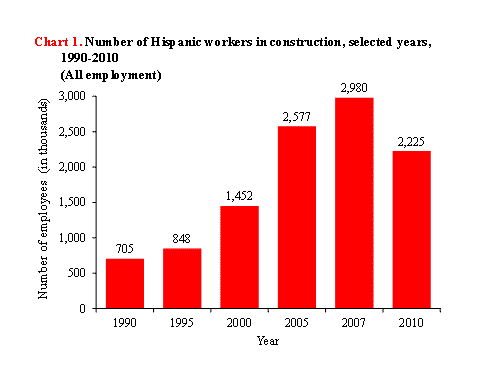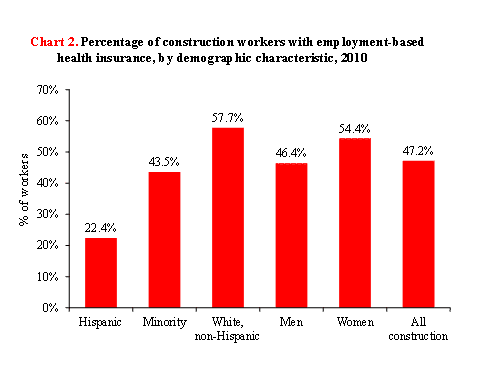Safety and Health Disparities among Construction Workers (Completed 2009-2014)
Xiuwen (Sue) Dong, DrPH
CPWR
Ph: 301-578-8500 ext.8528
[email protected]
Research Team
Xuanwen Wang, PhD, Julie Largay, MPH
CPWR’s study of safety and health disparities draws from a wide variety of construction industry subgroups, with a special research focus on the Hispanic workforce. A recent study examined the impact of language barriers on healthcare utilization among Hispanic construction workers. Hispanic workers – particularly those who lack proficiency in English – lagged far behind their white, non-Hispanic counterparts in healthcare utilization. Data Center staff presented these findings at the 17th Annual National Hispanic Medical Association Conference and published the results as a book chapter, “The Impact of Language Barriers on Healthcare Utilization among Hispanic Construction Workers,” Owen T Jackson & Kathleen A Evans (Eds.), Health Disparities: Epidemiology, Racial/Ethnic and Socioeconomic Risk Factors and Strategies for Elimination. Hauppauge, NY: Nova Science Publishers, Inc. The Data Center presented findings on Hispanic workers at the 3rd Annual Southeastern Occupational Network (SouthON) Meeting in October 2013.
Trends of Hispanic Employment in Construction
Hispanic employment in construction dramatically increased during the boom of the U.S. housing market. The number of Hispanic construction workers grew from 700,000 in 1990 to nearly 3 million in 2007. Since the economic crisis starting in 2007, Hispanic employment in construction dropped to 2.2 million by 2010. For the first time in decades, the Hispanic share of the construction workforce stopped climbing (Chart 1). Foreign-born workers accounted for most of the workforce growth and decline in construction. Hispanic immigrant workers increased from 0.4 million in 1995 to 2.3 million in 2007, then declined to 1.6 million during the economic downturn.
Fatal and Nonfatal Injuries among Hispanic Construction Workers
The fatality rate for Hispanics was consistently higher than white, non-Hispanic workers in 1992 -2006 (by 41% higher on average), but the rate among Hispanics decreased at a faster pace than the rate for white, non-Hispanics during the economic downturn. The rate reduction among Hispanic workers in recent years could be partially attributed to a disproportionate decrease in high-risk worker groups, such as fewer younger and new immigrants, and less inexperienced workers among this subpopulation in construction.
The rate of nonfatal injuries among Hispanic workers continues to drop following the overall injury trends in construction. The rate remained slightly lower among Hispanics than white, non-Hispanics according to the BLS annual survey of occupational injuries and illnesses. However, the team’s findings from a household survey indicate that Hispanic construction workers were more likely than their white, non-Hispanic counterparts to suffer medical conditions from work-related injuries. This suggests underreporting in nonfatal injuries captured by BLS. The findings were published in the American Journal of Industrial Medicine (2010;53(6):561-9). http://www.ncbi.nlm.nih.gov/pubmed/20187004
Health Insurance Coverage and Healthcare Utilization
Healthcare disparities in construction remain significant. In 2010, only 22% of Hispanics had employer-provided health insurance compared to 58% of white, non-Hispanics (Chart 2). The disparity was even greater for smaller establishments and non-union workers. Among construction establishments with fewer than 10 employees, only 9% of Hispanic workers had employment-based insurance. As a result, more than one-third (36%) of Hispanic construction workers did not receive any kind of preventive care in 2010, more than double the proportion for their white, non-Hispanic counterparts (17%).
Language Barriers to Healthcare among Hispanic Construction workers
About 80% of Hispanic construction workers spoke a language other than English at home; and more than one-third (37%) did not speak English very well or did not speak English at all. Hispanic workers lagged far behind their white, non-Hispanic counterparts in terms of healthcare utilization, particularly for those who lack fluency in English. These findings were presented at the 17th Annual National Hispanic Medical Association Conference and published as a book chapter: The Impact of Language Barriers on Healthcare Utilization among Hispanic Construction Workers. (2013. In Owen T Jackson & Kathleen A Evans (Eds.), Health Disparities: Epidemiology, Racial/Ethnic and Socioeconomic Risk Factors and Strategies for Elimination. Hauppauge, NY: Nova Science Publishers, Inc).


